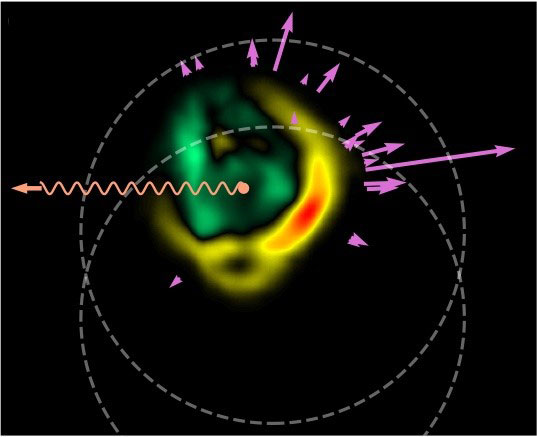Searching for Mach Waves Inside a Perfect Liquid
Researchers develop a 2D tomography technique that will enable the search for Mach waves in the smallest droplets of quark-gluon plasma.

The Science
Nuclear scientists create the hottest matter in the universe by colliding nuclei at almost the speed of light. At such high temperatures, almost a million times hotter than the Sun, nuclear matter melts into a soup of subatomic particles called quarks and gluons. This quark-gluon plasma has almost no resistance to flow, making it the world’s most perfect fluid. The nuclear collisions also produce energetic particles that go through the quark-gluon plasma and create Mach shock waves like a supersonic jet zipping through the sky. Detecting Mach waves in the quark-gluon plasma is difficult. Now, an international effort has used a method called tomography to enhance the Mach wave signals.
The Impact
The shape of a Mach wave in a medium—whether air, water, or quark-gluon plasma—is determined by the sound velocity. It can offer important information about quark-gluon plasma. This includes properties that scientists know little about. Because the quark-gluon plasma existed in the early universe a fraction of a second after the Big Bang, understanding its properties helps scientists understand the early universe. This makes it important to develop experimental techniques able to enhance the Mach wave’s signal to make it more detectable as it passes through a quark-gluon plasma.
Summary
Researchers developed a 2-dimensional tomography technique to select the types of nuclear collisions in which energetic particles traverse the maximum length inside the quark-gluon plasma. The team used supercomputers to simulate nuclear collisions and the propagation of Mach waves. They found this 2-dimensional tomography enhances the Mach wave signals and facilitates their detection in future experiments. This will help to reveal properties of the quark-gluon plasma such as the sound velocity.
Contact
Xin-Nian Wang
Lawrence Berkeley National Laboratory
xnwang@lbl.gov
Funding
This work was supported in part by the Department of Energy Office of Science, Office of Nuclear Physics, by U.S. National Science Foundation within the JETSCAPE and the X-SCAPE Collaboration, by Natural Science Foundation of China, and by the Fundamental Research Funds for Central Universities in China.
Publications
Chen, W., et al., Search for the Elusive Jet-Induced Diffusion Wake in Z/gamma-Jets with 2D Jet Tomography in High-Energy Heavy-Ion Collisions. Physical Review Letters 127, 8, 082301 (2021). [DOI: 10.1103/PhysRevLett.127.082301]
Related Links
Scientists Take a Closer Look Inside the Perfect Fluid, Phys.org news
Solving a Cosmic Conundrum: “Perfect Fluid” Brings Us Closer to Understanding How Our Universe Began, Sci Tech Daily
Highlight Categories
Program: NP
Performer: DOE Laboratory



